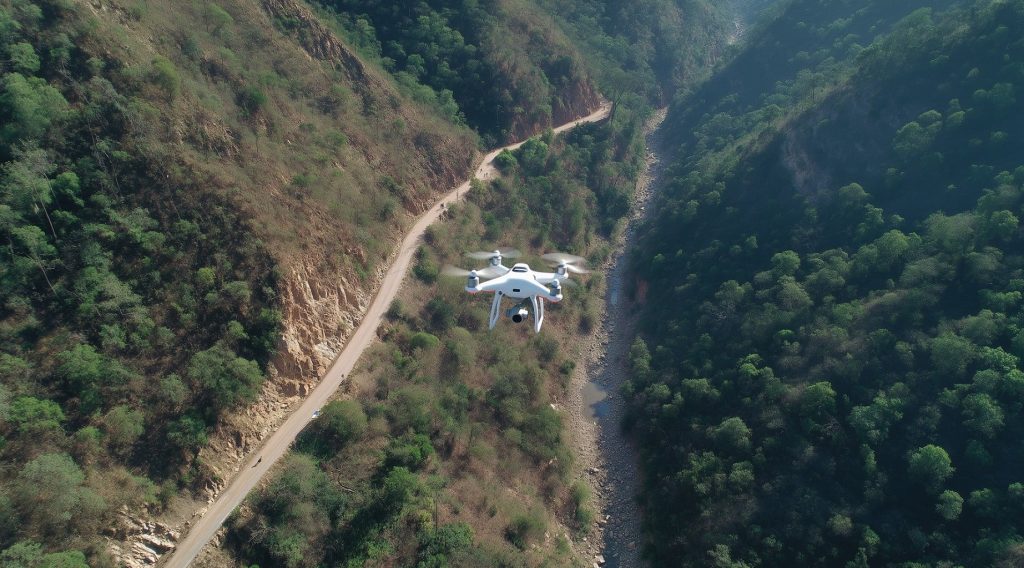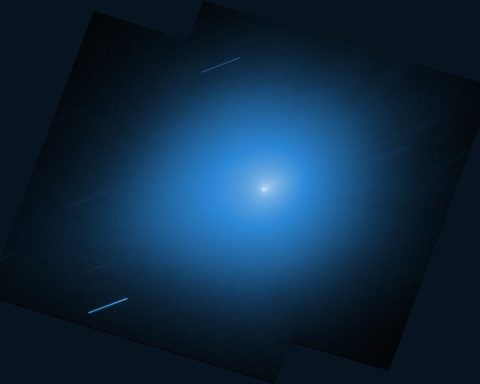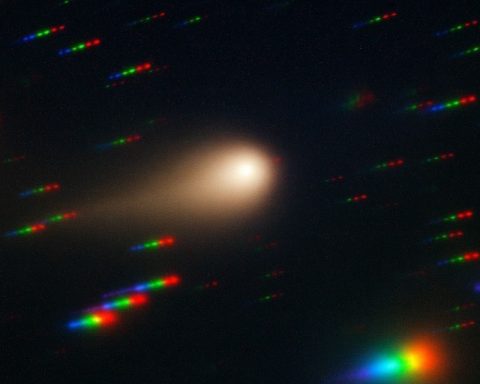- Shubhanshu Shukla became India’s 634th person in space, traveling to the ISS on the Axiom-4 mission after a 28-hour journey and a 41-year hiatus.
- NASA and Roscosmos are conducting investigations as four astronauts arrive at the ISS amid a mysterious air leak detected in the Russian Zvezda module.
- The Vera C. Rubin Observatory achieved first light with a 3,200-megapixel camera, discovering over 2,000 asteroids in 10 hours and planning to image the entire sky every few nights for a decade.
- The James Webb Space Telescope directly imaged its first exoplanet, TWA 7b, a Saturn-mass world about 111 light-years away.
- Japan’s GOSAT-GW satellite will launch on June 28 as the 50th and final H-2A mission, continuing greenhouse-gas and water-cycle monitoring.
- ESA’s Biomass satellite uses P-band radar to measure forest carbon storage in trunks and roots and has released its first images.
- UK Space Forge’s ForgeStar-1, the first Wales-developed satellite, reached orbit on SpaceX’s Transporter-14 to test semiconductor manufacturing in microgravity and satellite re-entry technology.
- SpaceX set a record by launching two Falcon 9 rockets in one day, and by 2025 had deployed nearly 1,500 Starlink satellites.
- Perseverance uncovered clay-bearing bedrock on the Jezero crater rim and manganese hydroxide, signaling ancient water activity and complex geochemical processes.
- SpaceX Starship debris has drawn Mexican environmental concerns as debris harms marine ecosystems along Tamaulipas beaches, prompting investigations.
June 2025 Space News: Breakthroughs, Missions, and the Expanding Frontier
Table of Contents
1. Introduction 2. Space Exploration and Human Spaceflight- Axiom-4: India’s Return to Human Spaceflight
- ISS Operations Amidst Air Leak Concerns
- Blue Origin’s New Shepard NS-33 Launch
- ESA’s Biomass and Forest Carbon Monitoring
- Japan’s GOSAT-GW and the Final H-2A Launch
- Airbus CO3D and 3D Mapping Missions
- Egypt’s Satellite Healthcare Initiatives
- UK’s ForgeStar-1: Semiconductor Manufacturing in Space
- SpaceX’s Record-Breaking Launch Cadence
- Rocket Lab’s Secretive and 5G Missions
- Vera C. Rubin Observatory: A New Era in Sky Surveys
- James Webb Space Telescope: Exoplanets and Cosmic Mysteries
- NASA’s Chandra and Multi-Wavelength Astronomy
- Rubin Observatory’s Asteroid Discoveries
- Meteor Fireballs Over the U.S.
- Are We Ready for an Asteroid Strike?
- Iran’s Fordow Nuclear Facility: Satellite Revelations
- Satellite Monitoring in Conflict Zones
- Weather Satellite Data and National Security
- Satellite Breakups and the Insurance Crisis
- SpaceX Starship Environmental Impact
- Satellite Reentry and Air Pollution
- Laser Satellite Communications and IoT
- DE-CIX, Starlink, and Kuiper: The Space Internet
- Vantablack and the Fight Against Light Pollution
Introduction
June 2025 has been a landmark month for space science, technology, and exploration. From the launch of new satellites and the expansion of in-orbit manufacturing to the unveiling of revolutionary astronomical observatories and the detection of mysterious signals from defunct spacecraft, the pace of progress is accelerating. This comprehensive review synthesizes the latest developments, missions, and discoveries, providing context and analysis for the rapidly evolving space sector.Space Exploration and Human Spaceflight
Axiom-4: India’s Return to Human Spaceflight
After a 41-year hiatus, India has returned to human spaceflight with astronaut Shubhanshu Shukla’s journey aboard the International Space Station (ISS) as part of the Axiom-4 mission. Prime Minister Narendra Modi’s live interaction with Shukla underscored the national significance of this milestone and India’s growing ambitions in space.- Shukla became the 634th person in space, joining the ISS after a 28-hour journey ( [1]).
- The Ax-4 crew is engaged in microgravity research, cargo transfers, and acclimatization ( [2]).
- Shukla is sleeping in the Dragon capsule, highlighting the evolving logistics of private and international crew missions ( [3]).
- India’s human spaceflight program is back on the global stage.
- Axiom-4 demonstrates international cooperation and the rise of commercial crewed missions.
ISS Operations Amidst Air Leak Concerns
The ISS continues to be a hub of scientific activity, but not without challenges. NASA and SpaceX launched four astronauts to the station even as a mysterious air leak in the Russian Zvezda module, first detected in 2019, changed behavior and raised concerns about station integrity ( [4]).Key Points:- Ongoing investigations by NASA and Roscosmos.
- Crew safety and station maintenance remain top priorities.
Blue Origin’s New Shepard NS-33 Launch
Blue Origin is set to attempt the NS-33 crewed launch of its New Shepard spacecraft near Van Horn, Texas, aiming to take six people to the edge of space for a brief weightlessness experience ( [5]).Satellite Technology and Earth Observation
ESA’s Biomass and Forest Carbon Monitoring
ESA’s Biomass satellite, launched in April, is revolutionizing forest monitoring with its P-band radar, capable of penetrating dense canopies and measuring carbon storage in trunks and roots ( [6]).- First images have been released, providing direct measurements of forest biomass ( [7]).
- The satellite supports global climate goals by enabling accurate tracking of deforestation and carbon sequestration ( [8]).
- Direct, repeatable observations of forests worldwide.
- Essential for climate change modeling and policy.
Japan’s GOSAT-GW and the Final H-2A Launch
Japan’s JAXA will launch the GOSAT-GW satellite on June 28, marking the 50th and final flight of the H-2A rocket. GOSAT-GW will monitor greenhouse gases and water cycles, continuing Japan’s leadership in Earth observation ( [9]).Airbus CO3D and 3D Mapping Missions
Four next-generation CO3D satellites, developed by Airbus and CNES, have departed Toulouse for launch in French Guiana. These satellites will deliver high-resolution 3D surface models and stereoscopic imagery for governmental and commercial applications ( [10]).Egypt’s Satellite Healthcare Initiatives
Dr. Islam Abou El-Magd, head of Egypt’s National Authority for Remote Sensing and Space Sciences, emphasized the role of satellites in healthcare at Africa Health ExCon 2025. Satellite data supports telemedicine, environmental monitoring, and healthcare delivery in remote regions ( [11]).Space Industry and In-Orbit Manufacturing
UK’s ForgeStar-1: Semiconductor Manufacturing in Space
Space Forge’s ForgeStar-1, the first satellite fully developed in Wales and the UK, has reached orbit via SpaceX’s Transporter-14 mission. The satellite aims to validate semiconductor manufacturing in microgravity, which could yield higher-quality chips for AI and quantum computing ( [12], [13]).- The mission also tests satellite re-entry technology.
- A major breakthrough for the UK’s space industry.
SpaceX’s Record-Breaking Launch Cadence
SpaceX set a new record by preparing and launching two Falcon 9 rockets in a single day, demonstrating exceptional operational efficiency ( [14]). In 2025 alone, SpaceX has deployed nearly 1,500 Starlink satellites, expanding global internet coverage ( [15], [16]).Rocket Lab’s Secretive and 5G Missions
Rocket Lab launched the EchoStar Lyra Block 1 S-band IoT satellite, supporting research for a global non-terrestrial 5G network ( [17], [18]). The company also completed a mysterious satellite launch for an undisclosed client, with more missions planned ( [19]).Astronomical Discoveries and Observatories
Vera C. Rubin Observatory: A New Era in Sky Surveys
The Vera C. Rubin Observatory in Chile has achieved first light, releasing its first images with the largest digital camera ever built (3,200 megapixels). In just 10 hours, it discovered over 2,000 new asteroids, including seven near-Earth objects ( [20], [21], [22]).- The observatory will image the entire sky every few nights for a decade ( [23]).
- It will generate more optical data in a year than all previous ground telescopes combined ( [24], [25]).
- The Legacy Survey of Space and Time (LSST) will map billions of galaxies and stars ( [26]).
- Rubin Observatory is transforming planetary defense, asteroid detection, and cosmic surveys.
James Webb Space Telescope: Exoplanets and Cosmic Mysteries
The James Webb Space Telescope (JWST) has directly imaged its first exoplanet, TWA 7b, a Saturn-mass world orbiting a young red dwarf star 111 light-years away ( [27]). This marks a significant advance in exoplanet discovery and direct imaging.- JWST also helped resolve the universe’s ‘missing baryonic matter’ mystery using fast radio bursts.
- Its folding design, 5-layer sunshield, and unprecedented sensitivity are revolutionizing astronomy ( [28]).
NASA’s Chandra and Multi-Wavelength Astronomy
NASA’s Chandra X-ray Observatory, in collaboration with other major telescopes, has produced a composite image of the Andromeda galaxy (M31), highlighting X-rays, ultraviolet, optical, infrared, and radio data ( [29]). This aids the study of dark matter and galactic structure.Mars Exploration: Rovers and New Findings
Curiosity’s Boxwork and Water Evidence
NASA’s Curiosity rover has found calcium sulfate veins in Mars’ boxwork terrain, suggesting groundwater persisted much longer than previously believed ( [30], [31]). These findings could reshape timelines for Mars’ habitability and climate evolution.Perseverance’s Ancient Clays and Manganese
NASA’s Perseverance rover detected clay-bearing bedrock on the Jezero crater rim, suggesting ancient water activity and the potential preservation of organic materials ( [32]). The rover also uncovered manganese hydroxide, indicating complex geochemical or microbial processes ( [33]).Planetary Defense and Meteor Events
Rubin Observatory’s Asteroid Discoveries
The Rubin Observatory’s rapid survey capability has already resulted in the discovery of over 2,000 new asteroids, including several near-Earth objects ( [34], [35]).Meteor Fireballs Over the U.S.
A mysterious bright fireball was seen by over 200 people across the southeastern U.S., likely a meteor or space debris ( [36]). Meteor fragments from the event landed in Henry County, Georgia, with the meteor disintegrating with the energy of 20 tons of TNT ( [37], [38]).Are We Ready for an Asteroid Strike?
Scientists are monitoring objects like YR4 2024 and Apophis. While catastrophic strikes are rare, even smaller asteroids pose risks to satellites, spacecraft, and astronauts. Ongoing efforts in planetary defense aim to protect Earth from potential collisions ( [39]).Space Security, National Defense, and Geopolitics
Iran’s Fordow Nuclear Facility: Satellite Revelations
A series of U.S. airstrikes targeted Iran’s Fordow nuclear facility, with satellite images from Maxar Technologies revealing extensive damage, craters, and ongoing reconstruction efforts ( [40], [41], [42], [43], [44], [45], [46]).Recap:- Satellite imagery is critical for monitoring nuclear proliferation and post-strike activities.
Satellite Monitoring in Conflict Zones
Satellites recorded explosions and fires at Kirovskoe airfield in Crimea after a drone attack, confirming hits on storage facilities, air defense sites, and aircraft ( [47], [48]).Weather Satellite Data and National Security
The U.S. Department of Defense has halted sharing satellite weather data with hurricane forecasters and scientists, citing cybersecurity concerns ( [49]). The sudden halt of the Defense Meteorological Satellite Program (DMSP) will end critical data collection for hurricane and Arctic monitoring ( [50]).Recap:- Loss of DMSP data could set hurricane forecasting back decades.
- National security and climate resilience are increasingly intertwined with space assets.
Space Debris, Insurance, and Environmental Concerns
Satellite Breakups and the Insurance Crisis
Satellite breakups are increasing as operators often launch uninsured due to soaring insurance costs. Only a small fraction of the 12,787 active satellites are insured, raising concerns about the sustainability of current practices in low Earth orbit ( [51]).SpaceX Starship Environmental Impact
SpaceX’s Starship explosions are under fire from Mexican environmentalists, who claim rocket debris is harming marine ecosystems along Tamaulipas beaches ( [52]).Satellite Reentry and Air Pollution
European scientists chased a falling ESA satellite by plane to study the atmospheric reentry process and its air pollution effects, detecting elements like lithium, potassium, and aluminum ( [53]).The Future: Connectivity, AI, and Space Infrastructure
Laser Satellite Communications and IoT
Chinese researchers have achieved a 1 Gbps laser communication link from a geostationary satellite, vastly outperforming Starlink’s 220 Mbps and reshaping global satellite communications strategies ( [54]). China Mobile unveiled RISC-V-based satellite IoT chips, accelerating AI integration ( [55]).DE-CIX, Starlink, and Kuiper: The Space Internet
German internet exchange operator DE-CIX is preparing to expand its infrastructure into space with the Space-IX project, collaborating with Starlink and Amazon’s Kuiper to enable fast data transmission between satellites and Earth ( [56]).Vantablack and the Fight Against Light Pollution
A new Vantablack 310 paint for satellites could dramatically cut light pollution by reducing reflected sunlight to just 2%, protecting astronomical research from satellite streaks ( [57]).Space Burial and Memorial Services
Celestis, a Houston-based company, specializes in space burials by sending cremated remains or DNA into orbit ( [58]). SpaceX’s Transporter 14 mission launched over 150 capsules containing DNA and human remains via Celestis’ memorial spaceflight service ( [59]). However, a memorial spaceflight carrying ashes and DNA of 166 people crashed into the Pacific Ocean after a parachute failure ( [60]), raising concerns for the growing space funeral industry.Conclusion and Outlook
June 2025 has showcased the extraordinary breadth and pace of space innovation. From the return of Indian astronauts to the ISS, the unveiling of the Vera C. Rubin Observatory’s cosmic survey capabilities, and the direct imaging of exoplanets by JWST, to the challenges of satellite debris, environmental impacts, and the geopolitics of space, the sector is more dynamic than ever.Key Takeaways:- Human spaceflight is becoming more international and commercial.
- Earth observation satellites are vital for climate, security, and resource management.
- In-orbit manufacturing and AI-driven connectivity are opening new industrial frontiers.
- Astronomical observatories are revolutionizing our understanding of the universe and planetary defense.
- Space debris and environmental impacts require urgent attention and international cooperation.
- The rest of 2025 promises further breakthroughs in lunar exploration, commercial spaceflight, and the integration of AI and quantum technologies into space infrastructure.
- The need for robust space governance, sustainability, and international collaboration has never been greater.
For more detailed coverage and ongoing updates, visit the original sources linked throughout this article.
More today’s sources
Satellite Images Reveal Activity at Fordow Nuclear Facility After US Strike
Satellite images from Maxar Technologies show new construction and earth-moving near Iran’s underground Fordow nuclear facility after a US airstrike. US intelligence and IAEA officials suggest enriched uranium stockpiles likely remain at the site, despite Iranian claims. The incident raises concerns about Iran’s nuclear capabilities and regional security.
Continue reading on [61]
PM Modi Interacts with Shubhanshu Shukla Aboard ISS During Axiom-4 Mission
Prime Minister Narendra Modi spoke with astronaut Shubhanshu Shukla aboard the International Space Station as part of the Axiom-4 mission. Shukla, the first Indian in space in 41 years, shared his experiences and highlighted India’s growing role in human spaceflight.
Continue reading on [62]
Japan to Launch GOSAT-GW on Final H-2A Rocket Mission June 28
Japan’s JAXA will launch the GOSAT-GW satellite on June 28, marking the 50th and final flight of the H-2A rocket. GOSAT-GW will monitor greenhouse gases and water cycles from orbit, continuing Japan’s efforts in Earth observation and climate monitoring.
Continue reading on [63]
ESA’s Biomass Satellite Reveals Forest Structure and Carbon Storage
ESA’s new Biomass satellite uses advanced radar to penetrate forest canopies, mapping the 3D structure of forests and accurately measuring carbon storage. This breakthrough enables better tracking of deforestation, climate change impacts, and ecosystem health, supporting global climate goals through detailed, repeatable observations of forests worldwide.
Continue reading on [64]
Egypt’s Remote Sensing Authority Highlights Satellite Role in Healthcare
Satellites and remote sensing technology are playing a vital role in healthcare, according to Dr. Islam Abou El-Magd, head of Egypt’s National Authority for Remote Sensing and Space Sciences. At Africa Health ExCon 2025, he emphasized how satellite data supports telemedicine, environmental monitoring, and healthcare delivery in remote African regions.
Continue reading on [65]
UK’s Space Forge Launches ForgeStar-1 Satellite to Validate Space-Based Semiconductor Manufacturing
Space Forge’s ForgeStar-1, the first satellite fully developed in Wales, has successfully reached orbit via SpaceX’s Transporter-14 mission. This milestone aims to validate semiconductor manufacturing in space, leveraging microgravity for higher-quality chips. The mission also tests satellite re-entry technology, marking a significant step for the UK’s space industry.
Continue reading on [66]
NASA and SpaceX Launch Four Astronauts Amid ISS Leak Concerns
Four astronauts launched to the ISS on Axiom Space Mission 4, as NASA and SpaceX address a mysterious air leak in the Russian Zvezda module. The leak, first detected in 2019, has recently changed behavior, raising concerns about the space station’s air integrity and prompting ongoing investigations by NASA and Roscosmos.
Continue reading on [67]
June 2025 Space Exploration Breakthroughs and Projects
June 2025 saw significant advancements in space exploration alongside other scientific fields. The report reviews recent space discoveries, missions, and upcoming projects for the remainder of 2025, highlighting key trends and expert insights in the space sector. Stay updated on the latest in space technology and exploration.
NASA Moon Rocket Booster Test Experiences Anomaly During Burn
A NASA test of the new BOLE solid rocket booster for future moon missions went awry, with debris and flames erupting late in the burn. The Northrop Grumman-built booster is key for upcoming Artemis launches. No injuries occurred, but the incident raises concerns about the rocket’s readiness for future space missions.
Continue reading on [68]
UK’s First Home-Built Satellite ForgeStar-1 Launched to Test Space Semiconductor Manufacturing
SpaceX launched ForgeStar-1, the first satellite fully developed in the UK, to validate semiconductor manufacturing in space. Built by Space Forge, the mission aims to leverage unique orbital conditions for high-quality chip production and test satellite reentry technology, marking a major breakthrough for the UK’s space industry.
Continue reading on [69]
Vera C. Rubin Observatory’s Giant Digital Camera Transforms Space Observation
The Vera C. Rubin Observatory has unveiled its first images using the largest digital camera ever built—a 3.2-gigapixel marvel. This revolutionary instrument will survey the entire Southern Hemisphere sky, advancing research on dark matter, dark energy, and cosmic events, and generating more optical data in one year than all previous ground telescopes combined.
Continue reading on [70]
India’s Shubhanshu Shukla Becomes Astronaut 634, Joins International Space Station
Indian astronaut Shubhanshu Shukla became the 634th person in space, joining the International Space Station after a 28-hour journey. Welcomed by the Expedition 73 crew, Shukla and his fellow astronauts will spend 14 days conducting scientific experiments and engaging with people on Earth, marking a milestone in India’s space journey.
Continue reading on [71]
NASA Curiosity Rover Discovers Evidence of Long-Lasting Water on Mars
NASA’s Curiosity rover has found calcium sulfate veins in Mars’ boxwork terrain, suggesting groundwater persisted much longer than previously believed. This discovery could reshape timelines for Mars’ habitability and climate evolution, as scientists analyze samples to better understand the planet’s hydrological history.
Continue reading on [72]
NASA’s Curiosity Rover Discovers Mysterious Boxwork Ridges on Mars
NASA’s Curiosity rover has uncovered a lattice of mineral boxwork ridges in Gale Crater, Mars, providing new evidence that groundwater persisted beneath the surface after surface water vanished. These unique formations, captured in detailed images, offer fresh insights into Martian geological history and the planet’s ancient water activity.
Continue reading on [73]
Satellite Images Reveal Repairs at Fordo Nuclear Site After US Bombing
New satellite images show construction equipment at Iran’s Fordo nuclear facility, recently struck by US bunker-buster bombs. The images reveal efforts to clear debris and restore access after visible craters were left by the attack. The extent of damage to Iran’s nuclear program remains unclear as restoration activities continue at the site.
Continue reading on [74]
Rubin Observatory Revolutionizes Asteroid Detection with First Images
The Vera C. Rubin Observatory has unveiled its first images, discovering over 2,000 new asteroids—including seven near-Earth objects—in just 10 hours. Its advanced telescope and digital camera promise to transform planetary defense by enabling unprecedented, rapid surveys of the southern sky, vastly increasing the detection and tracking of potentially hazardous space rocks.
Continue reading on [75]
SpaceX Launches UK’s First In-Space Semiconductor Manufacturing Satellite
SpaceX launched Space Forge’s ForgeStar-1, the UK’s first in-space manufacturing satellite, to produce semiconductors in low Earth orbit. Utilizing the vacuum and subzero temperatures of space, the mission aims to advance AI data centers and quantum computing. ForgeStar-1 serves as a proof-of-concept for future space-based manufacturing missions.
Continue reading on [76]
Jackson’s Connection to NASA: Astronaut James McDivitt and the Apollo Missions
Jackson, MI, boasts ties to space exploration through astronaut James McDivitt, who commanded NASA’s Gemini IV and Apollo 9 missions, crucial in paving the way for the moon landing. McDivitt also managed five Apollo missions post-Apollo 11, cementing Jackson’s legacy in NASA history.
Continue reading on [77]
Bootid Meteor Shower 2024: Peak Date and Best Viewing Times
The Bootid meteor shower peaks between June 22 and July 2, with the best viewing likely before dawn or just after dusk on June 27. The meteor shower originates from the constellation Bootes and can occasionally produce spectacular displays, as seen in 1998.
Continue reading on [78]
SpaceX Sets New Record with Two Falcon 9 Launches in One Day
SpaceX achieved a new record by preparing and launching two Falcon 9 rockets within a single day. The Starlink 10-34 mission launched just over two days after the previous Starlink 10-16, deploying 27 Starlink V2 satellites. This demonstrates SpaceX’s exceptional operational efficiency and rapid launch turnaround capability.
Continue reading on [79]
Vera C. Rubin Observatory’s Giant Camera Captures First Cosmic Images
The Vera C. Rubin Observatory in Chile has released its first images using the largest digital camera ever built. This groundbreaking telescope will map billions of galaxies and stars, generating unprecedented data to revolutionize our understanding of the cosmos, dark matter, and dark energy over its decade-long survey.
Continue reading on [80]
Vera C. Rubin Observatory Begins Imaging the Entire Night Sky
The Vera C. Rubin Observatory in Chile has achieved first light, starting its mission to image the entire sky every few nights for ten years. With a 3200-megapixel camera and advanced machine learning, it will revolutionize astronomical data collection and help discover new cosmic phenomena.
Continue reading on [81]
SpaceX Wins $81.6M Space Force Contract for 2027 Weather Satellite Launch
SpaceX secured an $81.6 million contract to launch the USSF-178 mission in 2027, carrying the Weather System Follow-on – Microwave Space Vehicle 2 (WSF-M2) and experimental small satellites. This win strengthens SpaceX’s dominance in the National Security Space Launch (NSSL) Phase 3 program, supporting advanced weather monitoring and defense research.
Continue reading on [82]
US Defense Meteorological Satellite Data Loss Threatens Hurricane Forecasting
The sudden halt of the Defense Meteorological Satellite Program (DMSP) will end critical data collection for hurricane and Arctic monitoring. Scientists warn this could set hurricane forecasting back “decades,” as DMSP satellites provide unique, high-resolution atmospheric data vital for tracking storms and sea ice, with no adequate US replacement available.
Continue reading on [83]
SpaceX Falcon 9 Launching Starlink Satellites from Vandenberg
SpaceX will launch a Falcon 9 rocket from Vandenberg Space Force Base Saturday morning, deploying 26 Starlink satellites into low-Earth orbit. The first stage booster will land on a droneship in the Pacific. Residents may hear sonic booms. Backup launch windows are available, and a live webcast will begin five minutes before liftoff.
Continue reading on [84]
Satellite Captures Explosions and Fire at Kirovskoe Airfield in Crimea After Drone Attack
A satellite recorded explosions and fire at Kirovskoe airfield in Crimea following a drone attack on June 28. The imagery confirms hits on storage facilities, air defense sites, and aircraft, including burning helicopters and exploding fuel tanks, underscoring the role of satellite monitoring in conflict zones.
Continue reading on [85]
US Department of Defense Halts Sharing Satellite Weather Data with Forecasters
The US Department of Defense will stop providing crucial satellite weather data to hurricane forecasters and scientists, impacting real-time storm tracking and sea ice monitoring. The decision, citing cybersecurity concerns, ends a 40-year practice and leaves experts without vital atmospheric and oceanic information as hurricane season intensifies.
Continue reading on [86]
NASA’s Critical Role in National Security and Space Technology
NASA technology detected a major drone incursion over Langley Air Force Base, highlighting its vital role in national security. Beyond space exploration, NASA’s innovations enable satellite operations, anomaly detection, and advanced rocket development, reinforcing the agency’s importance for both defense and global communications.
Continue reading on [87]
Are We Doing Enough to Prevent a Devastating Asteroid Strike on Earth?
Scientists are taking the threat of asteroid impacts seriously, monitoring objects like YR4 2024 and Apophis. While catastrophic strikes are rare, even smaller asteroids pose risks to satellites, spacecraft, and astronauts. Ongoing efforts in planetary defense aim to protect Earth from potential collisions.
Continue reading on [88]
Airbus-Built CO3D Satellites Depart Toulouse for Special 3D Mapping Mission
Four next-generation CO3D satellites, developed by Airbus and CNES, have left Toulouse for launch in French Guiana. These dual-use satellites will deliver high-resolution 3D surface models and stereoscopic imagery, serving both governmental and commercial clients for applications in hydrology, geology, civil security, and urban planning.
Continue reading on [89]
Satellite Imagery Confirms Drone Attack and Fires at Kirovskoe Airfield in Crimea
Satellite images and NASA data confirmed multiple explosions and fires at the Kirovskoe airfield in Crimea after a drone attack. The strike reportedly destroyed ammunition depots, air defense systems, and possibly damaged helicopters and Su fighter jets. The incident highlights the role of satellite monitoring in documenting military events.
Continue reading on [90]
Satellite Images Reveal Suspicious Activity at Iran’s Fordow Nuclear Facility
Satellite images from Maxar Technologies show construction and heavy equipment near Iran’s underground Fordow facility. The activity, including sealed entrances and new roads, raises concerns about Iran’s nuclear ambitions and possible attempts to move uranium stockpiles, according to Israeli media interpretations.
Continue reading on [91]
Elon Musk Vows More Risky Starship Launches After Sixth Failure
SpaceX’s Starship has suffered its sixth failure, prompting Elon Musk to promise more risky launches. The reusable rocket, crucial for future Moon and Mars missions, faces scrutiny after repeated setbacks. Starship, SpaceX, and reusable rocket technology remain central to advancing deep space exploration despite recent catastrophic failures.
Continue reading on [92]
Ax-4 Crew Completes First Full Day on ISS: Mission Update
The Axiom Mission 4 (Ax-4) crew finished their first full day aboard the International Space Station, focusing on integration with Expedition 73, transferring high-priority cargo, and preparing for research experiments. The astronauts also trained on emergency procedures, ensuring smooth collaboration and safety during their stay in microgravity.
Continue reading on [93]
Bright Fireball Streaks Across Southeastern U.S. Sky, Possibly Meteor or Space Junk
A mysterious bright fireball was seen by over 200 people across the southeastern U.S., likely a meteor or space debris. The event, visible in broad daylight, caused amazement and even pierced a Georgia home’s roof. NASA notes such bright daytime fireballs are rare, usually caused by atmospheric friction.
Continue reading on [94]
SpaceX Transporter 14 to Launch Celestis Memorial DNA and Remains Capsules
SpaceX’s Transporter 14 mission will launch over 150 capsules containing DNA and human remains via Celestis’ memorial spaceflight service. The payload, hosted by The Exploration Company, will orbit Earth before reentry and recovery, marking a milestone in space-burial services and the first customer payloads for TEC’s spacecraft.
Continue reading on [95]
Upcoming SpaceX Rocket Launches from Vandenberg in June 2025
Two SpaceX launches are scheduled from Vandenberg Space Force Base in California for June 2025: the Transporter 14 rideshare mission on June 23 and a Starlink deployment on June 28. Both will use Falcon 9 rockets, with booster landings planned on the “Of Course I Still Love You” drone ship in the Pacific Ocean.
Continue reading on [96]
Perseverance Rover Discovers Ancient Clay Minerals on Mars’ Jezero Crater Rim
NASA’s Perseverance rover has detected clay-bearing bedrock on the Jezero crater rim, suggesting ancient water activity on Mars. These phyllosilicates could preserve organic materials and date back to the planet’s Noachian period, about 4 billion years ago. The Science Team is eager to sample these potentially ancient rocks for further study.
Continue reading on [97]
Texas Company Celestis Sends Human Remains and DNA to Space for Memorials
Celestis, a Houston-based company, specializes in space burials by sending cremated remains or DNA into orbit. Collaborating with SpaceX and other launch providers, Celestis has memorialized celebrities like ‘Star Trek’ actors. Their services start at $3,500, offering families a unique cosmic tribute, with remains either returning to Earth or vaporizing in the atmosphere.
Continue reading on [98]
Meteor Fragments Land in Henry County, Georgia After Spectacular Daylight Fireball
Meteor fragments from a fireball that exploded over Georgia have been found in Henry County. The meteor, seen moving at 30,000 mph, disintegrated with the energy of 20 tons of TNT. The rare daylight event was widely observed, with fragments damaging a local home. NASA and the American Meteor Society are investigating.
Continue reading on [99]
Northrop Grumman’s Artemis Booster Test Ends in Anomaly
Northrop Grumman’s test of a next-generation solid rocket booster for NASA’s Artemis program ended with a destructive nozzle failure. The BOLE booster, designed for future Artemis missions, aims to boost SLS thrust to nearly 10 million pounds. Despite the setback, the test provided valuable data for advancing large solid rocket motor technology.
Continue reading on [100]
Satellite Breakups Increase as Insurance Costs Soar, Operators Go Uninsured
Satellite breakups are rising, with operators often launching uninsured due to soaring insurance costs. As space debris accumulates, companies launch cheaper satellites at faster rates, worsening the problem. Only a small fraction of the 12,787 active satellites are insured, raising concerns about the sustainability of current practices in the increasingly crowded Low Earth Orbit.
Continue reading on [101]
Webb Telescope Directly Images Saturn-Mass Exoplanet; Major Astronomy Breakthroughs June 2025
The James Webb Space Telescope made its first direct discovery of a Saturn-mass exoplanet, TWA 7 b, marking a leap in exoplanet imaging. Astronomers also resolved the universe’s ‘missing baryonic matter‘ mystery using fast radio bursts, revealing most ordinary matter lies in the cosmic web between galaxies.
Vera C. Rubin Observatory’s Digital Camera Discovers 2,104 New Asteroids in 10 Hours
The Vera C. Rubin Observatory, equipped with the world’s largest digital camera, has captured images revealing 2,104 new asteroids and millions of galaxies within just a few hours. This marks a significant leap in visual astronomy and asteroid detection, showcasing the observatory’s revolutionary capabilities.
Continue reading on [102]
Blue Origin’s New Shepard NS-33 Launch: Viewing Guide Near Van Horn, Texas
Blue Origin is set to attempt the NS-33 crewed launch of its New Shepard spacecraft near Van Horn, Texas. The mission, delayed due to weather, aims to take six people to the edge of space for a brief weightlessness experience. Spectators can view the space launch from nearby highways, as no public viewing is allowed at the site.
Continue reading on [103]
China Surpasses Starlink with Record-Breaking Laser Satellite Technology
Chinese researchers have achieved a 1 Gbps laser communication link from a geostationary satellite, vastly outperforming Starlink’s 220 Mbps. This breakthrough leverages optical links for faster, more secure data transfer, challenging SpaceX’s dominance and reshaping global satellite communications strategies with advanced, high-altitude technology.
Continue reading on [104]
James Webb Space Telescope: Features, Mission, and Latest Discoveries
The James Webb Space Telescope is NASA’s premier observatory, orbiting 1.5 million km from Earth. Its folding design, 5-layer sunshield, and unprecedented sensitivity allow it to study the universe’s history, including the formation of the first galaxies. Webb delivers groundbreaking astronomical data for scientists worldwide.
Continue reading on [105]
SpaceX Starship Explosions Blamed for Environmental Harm in Mexico
SpaceX Starship explosions are under fire from Mexican environmentalists, who claim rocket debris is harming marine ecosystems. Recent incidents have killed dolphins, a sea turtle, and fish along Tamaulipas beaches. Mexican authorities are investigating, and President Sheinbaum may sue SpaceX if violations of international law are found.
Continue reading on [106]
NASA’s Defunct Satellite Emits Mysterious Radio Signal, Startles Scientists
A dead NASA satellite emitted a mysterious radio signal on June 13, 2024, initially linked to fast radio bursts (FRB). Scientists traced the source to the old Relay 2 satellite, identifying the signal as a static discharge caused by friction with Earth’s atmosphere, highlighting risks for future spacecraft and aiding research into artificial FRB signals.
Continue reading on [107]
Rocket Lab Launches Secret EchoStar Satellite for Global 5G Research
Rocket Lab successfully launched an Electron rocket carrying the EchoStar Lyra Block 1 S-band IoT satellite. The mission, ‘Symphony In The Stars,’ aims to support research for a global extraterrestrial 5G network. The satellite was placed in a 650 km orbit, with another similar launch planned later this year.
Continue reading on [108]
DE-CIX Plans Space Expansion with Starlink and Kuiper Satellites
German internet exchange operator DE-CIX is preparing to expand its infrastructure into space with the Space-IX project. Collaborating with Elon Musk’s Starlink and Amazon’s Kuiper, DE-CIX aims to enable fast data transmission between satellites and Earth, improving connectivity for underserved regions and supporting future technologies like AI and autonomous vehicles.
Continue reading on [109]
Meteor Fireball Explodes Over Georgia, Stuns Southeast
A meteor traveling at 30,000 mph exploded over Georgia, producing a fireball visible across South Carolina and Tennessee. The event, confirmed by NASA, caused a sonic boom and left debris, highlighting the rarity of such meteor occurrences in the region.
Continue reading on [110]
European Biomass Satellite Launched to Monitor Tropical Forests
The European Biomass satellite, launched in April, uses a P-band radar to penetrate dense tropical forests and measure carbon storage in trunks and roots. This advanced satellite aims to provide more accurate data on carbon sequestration by forests, helping scientists refine climate change estimates. The project cost €496 million and involved international collaboration.
Continue reading on [111]
Best Satellite NBN Plans in Australia for June 2025: Compare & Save
Explore the best satellite NBN plans in Australia for June 2025, including top providers like Activ8me. Compare unmetered data, speed tiers (NBN 25, 50, 100), and key features to find the right satellite internet option for your needs. Learn how plans are evaluated and discover major satellite NBN providers.
Continue reading on [112]
Perseverance Rover Uncovers Manganese Hydroxide on Mars, Hinting at Ancient Complex Processes
NASA’s Perseverance rover encountered a stubborn rock, Kenmore, on Mars, revealing manganese hydroxide—a first for the mission. This mineral suggests complex geochemical or microbial processes in Mars’ past. The discovery, enabled by advanced instruments, offers vital insights for future Martian exploration and resource utilization.
Continue reading on [113]
SpaceX Launches Falcon 9 with 27 Starlink Satellites from Florida
SpaceX successfully launched a Falcon 9 rocket carrying 27 Starlink broadband satellites from Cape Canaveral. In 2025 alone, SpaceX has deployed nearly 1,500 Starlink satellites to low Earth orbit, expanding global internet coverage. The mission used the Falcon 9 booster B1092 and follows recent crewed missions to the International Space Station (ISS).
Continue reading on [114]
New Satellite Images Reveal Increased Activity at Iran’s Fordow Nuclear Facility
Recent satellite images from Maxar Technologies show significant construction and excavation at Iran’s Fordow nuclear facility after a U.S. bunker-buster attack. The images reveal heavy equipment, new tunnels, and evidence of pre-strike protective measures, highlighting ongoing efforts to secure or repair the sensitive site.
Continue reading on [115]
Rocket Lab Launches EchoStar Lyra Block 1 S-band IoT Satellite to Orbit
Rocket Lab’s Electron rocket successfully launched the EchoStar Lyra Block 1 S-band IoT communications satellite into a 650 km orbit. The satellite will support research for a global non-terrestrial 5G network. The mission, ‘Symphony In The Stars,’ was launched from New Zealand, with another similar launch planned later this year.
Continue reading on [116]
Experimental European Spacecraft Lost at Sea After Successful Mission
An experimental spacecraft by The Exploration Company was lost in the ocean after a successful launch and re-entry. The Mission Possible capsule, launched from Vandenberg with SpaceX, lost contact minutes before splashdown. Despite the loss, the mission proved the viability of low-cost, off-the-shelf components for future spacecraft development.
Continue reading on [117]
Memorial Spaceflight Carrying Human Ashes Crashes into Pacific Ocean
A memorial spaceflight carrying ashes and DNA of 166 people crashed into the Pacific Ocean after a parachute failure. The Nyx capsule, part of SpaceX’s Transporter-14 mission, was unrecoverable, raising concerns for operator Celestis and The Exploration Company amid the growing space funeral industry.
Continue reading on [118]
NASA’s Chandra Reveals Stunning New Multi-Wavelength Image of Andromeda Galaxy
NASA’s Chandra X-ray Observatory, along with other major telescopes, has produced a composite image of the Andromeda galaxy (M31), highlighting X-rays, ultraviolet, optical, infrared, and radio data. This new view aids the study of dark matter and galactic structure, and honors Dr. Vera Rubin’s pioneering work.
Continue reading on [119]
Vera Rubin Telescope Captures 10 Million Galaxies in Groundbreaking Image
The Vera Rubin telescope has unveiled a stunning image featuring 10 million galaxies, allowing viewers to potentially spot galaxies never seen by humans before. This achievement highlights the telescope’s 3,200-megapixel camera and its role in the ambitious Legacy Survey of Space and Time (LSST), revolutionizing our exploration of the universe.
Continue reading on [120]
Vera C. Rubin Observatory Unveils Sharpest 3,200-Megapixel Images of Universe
Chile’s Vera C. Rubin Observatory, equipped with a 3,200-megapixel camera, has released its first ultra-sharp cosmic images. The observatory enables astronomers to rapidly collect vast data, discover new asteroids, and study dark matter. Its advanced technology and AI tools promise transformative insights into the formation of the solar system and potential asteroid threats.
Continue reading on [121]
China Mobile Launches Domestic RISC-V Satellite IoT Chips, Accelerates AI Integration
China Mobile unveiled two RISC-V-based satellite IoT chips—CM6650N and CM3510—aimed at enhancing satellite IoT connectivity and bridging cellular coverage gaps. The company also introduced an integrated IoT management platform and AI-powered solutions, highlighting China’s push for satellite IoT and AI convergence to boost industrial applications and market growth.
Continue reading on [122]
Rocket Lab Successfully Launches Mysterious Satellite on Electron Rocket
Rocket Lab has successfully launched a mysterious satellite into orbit with its Electron rocket during the ‘Symphony In The Stars’ mission. The satellite’s purpose remains undisclosed, serving an anonymous private client. Rocket Lab plans another Electron launch for the same client this year. The company is also developing its reusable Neutron rocket for future missions.
Continue reading on [123]
Scientists Track Falling Satellite to Study Air Pollution from Spacecraft Reentry
A team of European scientists chased a falling ESA satellite by plane to study the atmospheric reentry process and its air pollution effects. Using 26 cameras, they detected elements like lithium, potassium, and aluminum released during burn-up, providing new insights into how satellite incineration impacts Earth’s atmosphere.
Continue reading on [124]
Satellite Images Reveal Activity at Iran’s Fordow Nuclear Facility
Recent satellite imagery from Maxar Technologies shows excavation and construction equipment at Iran’s Fordow nuclear facility, suggesting possible reconstruction or relocation efforts. This follows U.S. airstrikes targeting Iranian nuclear sites, highlighting ongoing concerns about Iran’s nuclear program and the effectiveness of military strikes against deeply buried facilities.
Continue reading on [125]
ESA Releases First Images from Forest Carbon Monitoring Satellite
The European Space Agency (ESA) has released the first images from its newly launched forest carbon monitoring satellite. The satellite uses P-band synthetic aperture radar to penetrate clouds and tree canopies, directly measuring forest biomass. These images will help estimate global forest carbon stocks, crucial for understanding and combating climate change.
Continue reading on [126]
Vantablack Coating Could Reduce Satellite Light Pollution for Astronomy
A new Vantablack 310 paint for satellites could dramatically cut light pollution by reducing reflected sunlight to just 2%. This innovation aims to protect astronomical research, like that at the Vera Rubin Observatory, from satellite streaks that degrade telescope images as satellite megaconstellations proliferate.
Continue reading on [127]
James Webb Space Telescope Captures First Direct Image of Exoplanet
The James Webb Space Telescope has directly imaged its first exoplanet, TWA 7b, a Saturn-mass world orbiting a young red dwarf star 111 light-years away. This marks a significant advance in exoplanet discovery and direct imaging, showcasing Webb’s powerful infrared capabilities and advancing our understanding of planetary systems.
Continue reading on [128]
SpaceX Launches Falcon 9 with 27 Starlink Satellites from Florida
SpaceX successfully launched a Falcon 9 rocket carrying 27 Starlink broadband satellites from Florida on June 28, 2025. The mission, Starlink 10-34, used the Falcon 9 booster B1092. The launch was streamed live, highlighting SpaceX’s continued expansion of its satellite internet constellation.
Continue reading on [129]
Taiwan Internet Infrastructure: Fiber, 5G, and Satellite Connectivity
Taiwan leads in internet infrastructure with widespread fiber-optic broadband, robust 4G/5G mobile networks, and emerging satellite backup solutions. Over 63% of fixed broadband uses fiber, and 5G adoption is rapidly rising. Satellite connectivity is vital for remote areas and as a resilient backup, especially after recent undersea cable disruptions.
Plan-S Expands Connecta IoT Satellite Constellation to 17, Enhancing Gigabit Industrial Connectivity
Turkish firm Plan-S has expanded its Connecta IoT satellite constellation to 17, following the launch of four new satellites aboard SpaceX Falcon 9. This boosts Gigabit industrial IoT connectivity, significantly reduces latency, and enables real-time data for sectors like energy, mining, and logistics, advancing remote monitoring and control capabilities.
Satellite Images Reveal Aftermath of U.S. Strikes on Iran’s Nuclear Facilities
Satellite photos from Maxar Technologies reveal significant damage to Iran’s Fordo nuclear facility after the U.S. military’s use of bunker-buster bombs. The images show craters, ash, and blocked tunnel entrances, providing visual evidence of the impact on three key Iranian nuclear sites during Operation Midnight Hammer.
Continue reading on [130]
Axiom-4 Crew Begins Microgravity Research on ISS; Shubhanshu Shukla Sleeps in Dragon Capsule
The Axiom-4 crew has settled aboard the International Space Station, joining Expedition 73 for microgravity research. Crew members, including Shubhanshu Shukla, are acclimating, setting up sleeping quarters (Shukla in Dragon), and preparing for scientific experiments. Key tasks include cargo transfers, safety briefings, and familiarization with station systems.
Continue reading on [131]
Old NASA Satellite Relay 2 Sends Mysterious Signal After 60 Years
A defunct NASA satellite, Relay 2, unexpectedly emitted a strong radio pulse nearly 60 years after its last signal. Detected by Australian astronomers, the brief impulse has puzzled researchers, with theories ranging from space debris collision to electrostatic discharge. The event could provide insights into spacecraft safety and electrostatic hazards in space.
Continue reading on [132]
US Airstrikes on Iran’s Fordow Nuclear Facility Revealed by Satellite Images
Satellite images from Maxar show at least six large craters at Iran’s Fordow nuclear facility after a US airstrike, indicating the use of bunker-buster bombs. The operation, codenamed ‘Midnight Hammer,’ involved seven B-2 bombers and 75 precision-guided munitions, causing severe damage to three nuclear sites.
Continue reading on [133]
Mysterious Radio Signal Detected from NASA’s Dead Relay 2 Satellite
A mysterious radio burst was detected from NASA’s long-inactive Relay 2 satellite by ASKAP. The emission, between 695.5 and 1031.5 MHz, may be due to electrostatic discharge or a micrometeoroid impact. This finding could enable remote detection of hazardous discharges on spacecraft, improving satellite safety and astrophysical observations.
Continue reading on [134]
References
1. www.tribuneindia.com, 2. www.axiomspace.com, 3. timesofindia.indiatimes.com, 4. www.cnn.com, 5. www.elpasotimes.com, 6. www.usinenouvelle.com, 7. finance.sina.cn, 8. www.dagensps.se, 9. www.space.com, 10. actu.fr, 11. www.almasryalyoum.com, 12. finance.sina.cn, 13. www.tomshardware.com, 14. www.ixbt.com, 15. inbusiness.kz, 16. www.zakon.kz, 17. www.interfax.ru, 18. korrespondent.net, 19. www.vokrugsveta.ru, 20. gizmodo.com, 21. www.iflscience.com, 22. www.geo.tv, 23. hackaday.com, 24. www.vox.com, 25. www.wired.com, 26. www.iflscience.com, 27. skyandtelescope.org, 28. science.nasa.gov, 29. www.nasa.gov, 30. english.mathrubhumi.com, 31. scitechdaily.com, 32. www.miragenews.com, 33. universemagazine.com, 34. gizmodo.com, 35. www.iflscience.com, 36. www.oregonlive.com, 37. www.atlantanewsfirst.com, 38. www.cbsnews.com, 39. www.theguardian.com, 40. www.cbsnews.com, 41. www.news.cn, 42. www.money.pl, 43. adevarul.ro, 44. wiadomosci.dziennik.pl, 45. chinese.aljazeera.net, 46. news.creaders.net, 47. tsn.ua, 48. tsn.ua, 49. www.npr.org, 50. www.theguardian.com, 51. www.space.com, 52. www.extremetech.com, 53. www.space.com, 54. lanouvelletribune.info, 55. news.qq.com, 56. www.faz.net, 57. www.space.com, 58. www.usatoday.com, 59. www.space.com, 60. inshorts.com, 61. www.money.pl, 62. timesofindia.indiatimes.com, 63. www.space.com, 64. www.dagensps.se, 65. www.almasryalyoum.com, 66. finance.sina.cn, 67. www.cnn.com, 68. mashable.com, 69. finance.sina.cn, 70. www.vox.com, 71. www.tribuneindia.com, 72. english.mathrubhumi.com, 73. scitechdaily.com, 74. adevarul.ro, 75. gizmodo.com, 76. www.tomshardware.com, 77. www.mlive.com, 78. www.edinburghnews.scotsman.com, 79. www.ixbt.com, 80. www.wired.com, 81. hackaday.com, 82. spacenews.com, 83. www.theguardian.com, 84. www.ksby.com, 85. tsn.ua, 86. www.npr.org, 87. www.nytimes.com, 88. www.theguardian.com, 89. actu.fr, 90. tsn.ua, 91. wiadomosci.dziennik.pl, 92. www.space.com, 93. www.axiomspace.com, 94. www.oregonlive.com, 95. www.space.com, 96. www.vcstar.com, 97. www.miragenews.com, 98. www.usatoday.com, 99. www.atlantanewsfirst.com, 100. www.orlandosentinel.com, 101. www.space.com, 102. www.iflscience.com, 103. www.elpasotimes.com, 104. lanouvelletribune.info, 105. science.nasa.gov, 106. www.extremetech.com, 107. 3dnews.ru, 108. korrespondent.net, 109. www.faz.net, 110. www.cbsnews.com, 111. www.usinenouvelle.com, 112. www.whistleout.com.au, 113. universemagazine.com, 114. inbusiness.kz, 115. chinese.aljazeera.net, 116. www.interfax.ru, 117. futurism.com, 118. inshorts.com, 119. www.nasa.gov, 120. www.iflscience.com, 121. www.geo.tv, 122. news.qq.com, 123. www.vokrugsveta.ru, 124. www.space.com, 125. news.creaders.net, 126. finance.sina.com.cn, 127. www.space.com, 128. skyandtelescope.org, 129. www.zakon.kz, 130. www.cbsnews.com, 131. timesofindia.indiatimes.com, 132. t3n.de, 133. www.news.cn, 134. zap.aeiou.pt










